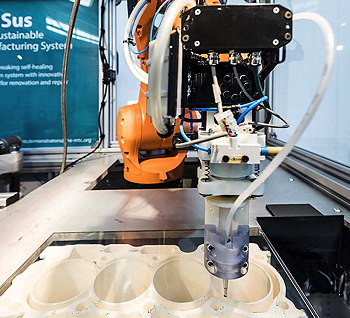- Home » News » Technology News
EU project could result in machinery that repairs itself

Engineers and researchers from six European countries have been taking part in a collaborative project aimed at developing maintenance technologies capable of predicting when production machinery is going to fail. This will allow plant managers to rectify faults before the breakdowns occur. In some cases, the system will even be able to correct defects automatically.
The Selsus (Health Monitoring and Life-Long Capability Management for Self-Sustaining Manufacturing Systems) project has been backed by almost €5.4m of funding from the European Commission. The four-year project, which is just ending, brought together 15 organisations, led by the Fraunhofer Institute for Manufacturing Engineering and Automation (Fraunhofer IPA) in Germany. The project’s UK partners included the Manufacturing Technology Centre (MTC) in Coventry, Loughborough University and the University of Nottingham, while its industrial partners included Ford and Electrolux.
The aim of the project has been to develop diagnostic procedures capable of monitoring the status of all of the components on a production line, identifying problems and weak points, and informing maintenance personnel, who can then repair any defects – ideally without having to interrupt production.
“The aim is not just to monitor the status of the machines and components,” explains Martin Kasperczyk from Fraunhofer IPA. “Using intelligent software and sensor networks, the plan is to detect potential weak points or signs of wear-and-tear early enough for the system to be able to predict potential malfunctions.”
Before the project could get underway, several hurdles had to be overcome. “One of the biggest challenges was analysing the flood of data,” Kasperczyk reports. “After all, we’re talking here about predicting malfunctions or breakdowns of machines with a high degree of reliability. You don’t get there just by programming a couple of algorithms.”
The diagnostic models developed during the project provide recommendations on how to rectify problems. For example, Electrolux in Italy, has been using such a decision-support system to predict potential failures on a press that it uses to produce washing machine facings, and to diagnose any malfunctions. The data comes partly from sensors that are measuring values such as energy consumption, temperature, oil pressure, particles in the oil, and vibrations.

In another part of the project, the UK’s MTC created a system with self-healing capabilities, based on a robotic arm operating in an engine production plant. A dispenser is attached to the arm using a vacuum. If the dispenser encounters resistance, rather than snapping off, it reacts flexibly, losing the grip produced under vacuum and dropping a few centimetres until it is stopped by springs. The springs then return the dispenser to its original position. Subsequent calibration ensures the tool is in the correct position and, after the brief interruption, work resumes.
The SelSus project relies on Bayesian networks – mathematical models that can compute the probabilities of a certain event or state occurring. The model represents a set of variables and their conditional dependencies. With the help of the data collected by sensors, for example, the software can compute the probability that a specific cable will soon break, and can signal that it should be replaced.
The software also takes into account the technical characteristics of the machine and its performance parameters. This data is captured when installing and configuring the machine. Test runs also tell the software how the machine and its components behave in continuous operation and under load. Only then is it ready for use. The software can also register new data – for instance, as a result of machine upgrades or a deterioration in performance due to wear – allowing the system to learn.
The software even interacts with operators by analysing the causes of potential or existing malfunctions and proposing an appropriate course of action.





